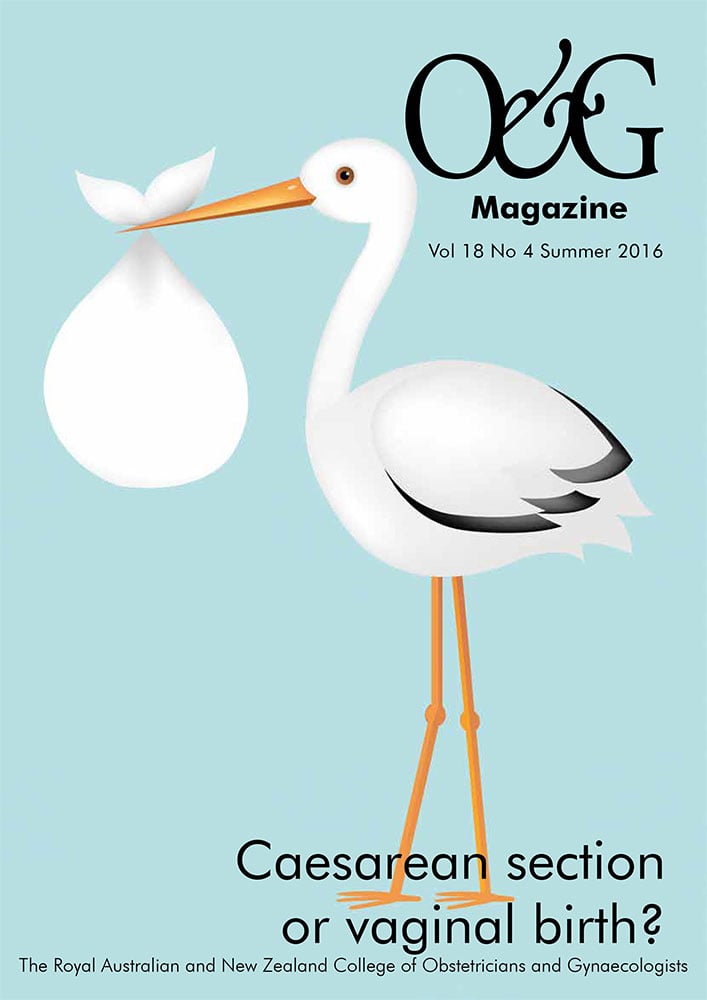After 33 years practising obstetrics, it was with initial enthusiasm, subsequently tempered with a liberal dash of caution, that I accepted the invitation to write the editorial for this issue of O&G Magazine themed ‘caesarean section or vaginal birth’. However, I was pleased to see that neither the words ‘normal’ nor ‘natural’ had been co-opted in the title to accompany either mode of birth.
Obstetrics is a relatively simple art – after all is said and done, there are only two ways to give birth. Why then, do we as obstetricians commonly undertake with the very best intentions an operation that must surely be the most politicised medical procedure ever? Why is operative birth ‘abnormal’, and any form of vaginal birth ‘normal’? We all sit in morning handover and hear the night registrar describes a ‘normal’ vaginal birth with a third-degree tear and 1.8 L postpartum haemorrhage – another caesarean statistic avoided.
How have we got to this point in one of the most collaborative professions in healthcare? We as clinicians quite rightly follow careful guidelines when consenting patients for caesarean section (CS), grappling with evolving data on risks for future pregnancies, including future placental disasters and even possibly stillbirth, but can still be left with the impression some other course of action may have been better.
Reading through his issue of O&G Magazine, I reflected on how much intellectual rigour and, where possible, evidence-based opinions, have been applied to this often emotive debate about CS. The broad scope and detail of the contributions left me wanting to see this issue of the magazine in the newsagents, supermarkets and airport shops alongside all the celebrity pulp, as a way of putting a more balanced view on mode of birth to our target audience.
The operation CS is, as pointed out by Frances Hills (page 15), the most commonly performed surgical procedure for women. The indications are many and varied, ranging from patient requested elective CS to the more dramatic and challenging procedures performed for placenta praevia accreta that may culminate in an undoubtedly lifesaving peripartum hysterectomy. When all these indications are bundled into one clinical indicator (CS rate expressed as percentage), its usefulness as a quality improvement or audit tool is impaired, but sometimes, unfortunately, the raw rate of CS does provide a focus for those who believe emphatically that ‘less is best’ when it comes to CS. Perhaps we should occasionally ask the question: ‘is my/our CS rate high enough?’
Robson’s classification1 of CS indications into 10 mutually exclusive groups did much to allow clinicians to audit with improved focus and clarity, and attempts to modify CS rates within these groups allowed evidence-based changes to be assessed for effectiveness within a defined quality and safety framework.
In obstetrics, it is paramount to be clear as to the difference between association and causation when examining specific outcomes. The debate that continues around CS, particularly with respect to the indications for, and outcomes from, CS, exemplifies the importance of this distinction, as emphasised in the articles in this issue.
Several of the articles in this issue encourage us to focus not only on the immediate peripartum factors, but also to consider the longer-term effects of our advice to parents about mode of birth on the infant, child and possibly the adult. I admit to some initial eye-rolling and heavy sighing when vaginal seeding was first broached with me at an emergency CS, but the article by Chu et al (page 47) clearly puts the case for at the very least better understanding of evidence and arguments in the current literature relating to the neonatal microbiome and its possible influence on future health. Broader than just the microbiome are the issues of child and adult health that may be influenced by mode of birth, as described by Bendall and Ellwood (page 20).
Healthcare is all about costs in our current era of finite funding. The article by Thevathasan and Woodrow (page 26) explores the comparative costs of several modes of birth, and concludes that accurate estimates of health expenditure are limited by a variety of factors.
Lastly, the issue of consent for both modes of birth is now very much to the forefront of debate around birth, and no discussion that includes the phrase ‘woman’s right to autonomy and choice’ can exclude this topic, as detailed in the paper by Lin and Atan (page 22). A detailed and timely discussion during the antenatal period must now include risks of pelvic floor injury and the longer term consequences with respect to continence, sexual function and quality-of-life issues.
The key message is respect for all opinions, while continuing to oppose the demonisation of a surgical operation that has undoubtedly contributed to the health and wellbeing of countless mothers and babies over the last two centuries. Espousing the mantra of ‘woman-centred care’ is only the beginning: it is how we as clinicians apply our knowledge, intellect and empathy to empower through information those who place their trust in our professions that we may be judged to be good and competent obstetric care-givers.






Leave a Reply